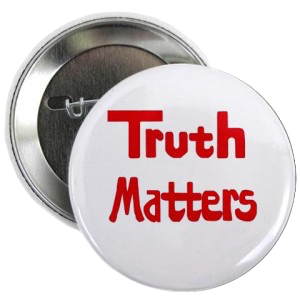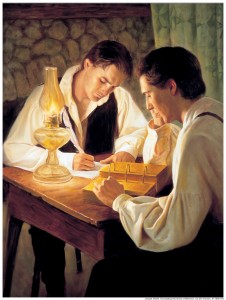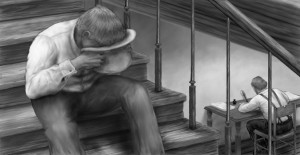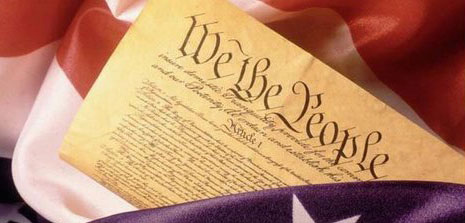Podcast: Play in new window | Download (Duration: 14:00 — 12.8MB)
Subscribe: Apple Podcasts | RSS
Podcast: Play in new window | Download (Duration: 14:00 — 12.8MB)
Subscribe: Apple Podcasts | RSS
Chris Duckworth, a Lutheran pastor in Indiana, wasn’t happy when a 12-page advertising supplement arrived on his doorstep last week. The “Non-Mormon Temple Visitors Guide” was published by Tri-Grace Ministries and distributed to communities in preparation for the LDS Temple Open House event scheduled to begin on July 17th (2015).
 On his blog, Reverend Duckworth posted a piece he titled “Mormon Bashing,” in which he argued that the Tri-Grace publication was a form of “public bullying” and “not beneficial” to the community. Dismissing theological issues while quoting 1 Corinthians 10:23, Rev. Duckworth wrote that he plans to attend the Mormon Temple Open House in an effort to (quoting Martin Luther) “come to their defense, speak well of them, and interpret everything they do in the best possible light” as well as to “stand with my friends and neighbors against the unfair attacks and slander.” He explained,
On his blog, Reverend Duckworth posted a piece he titled “Mormon Bashing,” in which he argued that the Tri-Grace publication was a form of “public bullying” and “not beneficial” to the community. Dismissing theological issues while quoting 1 Corinthians 10:23, Rev. Duckworth wrote that he plans to attend the Mormon Temple Open House in an effort to (quoting Martin Luther) “come to their defense, speak well of them, and interpret everything they do in the best possible light” as well as to “stand with my friends and neighbors against the unfair attacks and slander.” He explained,
“Theological differences between the Mormon Church and the Lutheran Church are real. But so too is the unfair treatment our neighbors, friends, and fellow children of God of the Mormon Church receive to this day. My friends and neighbors don’t deserve to receive, on their doorstep, such a publication. I cannot remain silent. I have to speak out.”
Rev. Duckworth’s comments were praised by some, and challenged by others. Responding to one commenter that suggested he was moving toward conversion to Mormonism, Rev. Duckworth wrote,
“Nothing could be further from the truth. I am not in the process of conversion. I am simply saying that no group of fellow citizens and children of God deserve to have a 12-page screed ripping their religion delivered to their doorstep by a ‘newspaper’ that purports to serve the community and be a community asset.”
Rev. Duckworth repeated this concern several more times as he continued to respond to critics:
“All that I claim is that no group deserves to have a 12-page attack on their religion thrown on their lawn – and on the lawns of thousands of their neighbors. That is patently unfair and unChristian.”
“I have little interest either in defending or in disparaging the faith of my friends and neighbors. I simply believe they – or anyone – do not deserve to have a 12-page attack on their faith delivered to their doorstep by a newspaper purporting to serve our community.”
“I simply don’t believe that they – or any group of our neighbors, friends, fellow citizens – deserve to have a 12-page screed criticizing their faith thrown on their lawn wrapped in a garment that purports to be ‘news’ and a publication serving the community.”
As a Christian dedicated to evangelism, I found many things in Rev. Duckworth’s blog that troubled me, especially his repeated assertions centering on what he believes Mormons “deserve.” I responded, posting this comment:
“Chris, your argument is centered on what Mormons ‘deserve’ (or don’t deserve). Christians have some experience with the concept of getting what we deserve. From God’s perspective we are all sinners and deserve eternal punishment and separation from God. But God, in His mercy, has confronted our sin and offered us the gift of reconciliation and eternal life in Him. This we do not deserve; this is God’s grace. Mormons (like all of us) need God’s grace. They need to have their sin (including the idolatry of Mormonism) confronted. You say they do not deserve to have this confrontation delivered to their doorstep. On the contrary, Tri-Grace Ministries is a vehicle of God’s grace for the Mormon people, as well as for people who are unaware of the doctrines of Mormonism who are at risk of being deceived by the public relations presentation they will hear at the temple open house. Don’t these people ‘deserve’ God’s grace? Well, actually, no, they don’t. But our great God is merciful, and He calls His people to speak the truth in love. None of us deserve God’s grace, but neither do Mormons ‘deserve’ to have God’s gracious truth withheld from them in an effort to protect their feelings. May God move in a mighty way among the Mormon people of Indiana, and may He continue to use the Christians of Tri-Grace Ministries as His ambassadors of true and lasting peace.”
Christians, please join me in praying for the Christian outreach at the Indianapolis Indiana Temple. May God, in His mercy, rescue the perishing.
Podcast: Play in new window | Download (Duration: 14:00 — 12.8MB)
Subscribe: Apple Podcasts | RSS
The annual Christian outreach at the Mormon Miracle Pageant in Manti, Utah concluded about 2 weeks ago. During this year’s outreach, 34 women, dressed in pioneer clothing, each took on the identity of a wife of Joseph Smith. This was a powerful visual representation that helped Mormons better understand what 34 wives actually looks like. Eric Johnson snapped a couple of photos of the actresses gathered together. In this one, rather than smiling for the camera, the women’s expressions reflect the discontent of their polygamous identities:

When this same visual representation was performed in Manti for the first time (in 2008), most Mormons were completely unaware that Joseph Smith had more than one wife. They reacted to the parade of 34 women with the accusation that the whole thing was nothing but a vile lie. Even though the Mormon Church itself has now published an essay that admits Joseph had up to 40 wives, many Mormons still do not know that Emma was but one of Joseph’s dozens of plural wives.
In this short (4-minute) video, Aaron names Joseph Smith’s wives and provides a few important facts about these women. This, too, is a powerful visual presentation.
For more information about Joseph Smith’s polygamy, check out this excellent video of Chip Thompson and Doris Hanson discussing and teaching on the topic. This video also presents a visual representation of Joseph Smith’s 34 wives – along with 11 additional husbands to whom Joseph’s plural wives were also married.
Assistant BYU professor, author, and artist Anthony Sweat created the “feature image” for a new book (From Darkness Unto Light, by Michael Hubbard MacKay and Gerrit J. Dirkmaat) that depicts the translation of the Book of Mormon. His painting includes the historically accurate image of Joseph Smith preparing to gaze into a hat, where his seer stone is (presumably) housed.
In an appendix to the book, Dr. Sweat discusses the tension between art and history. The article is essentially an apologetic for the Mormon Church’s oft-criticized tradition of depicting Joseph Smith’s translation of the Book of Mormon in a historically inaccurate way.
 Dr. Sweat affirms, “none of the currently used Church images of the translation of the Book of Mormon are consistent with the historical record” (234). Over a 43-year span of representations of the Book of Mormon translation published in the Church’s Ensign magazine, Dr. Sweat found that 17 different images had been used 55 times, all of them being “inconsistent with aspects of documented Church history of the translation process of the Book of Mormon” (234). He rhetorically asks,
Dr. Sweat affirms, “none of the currently used Church images of the translation of the Book of Mormon are consistent with the historical record” (234). Over a 43-year span of representations of the Book of Mormon translation published in the Church’s Ensign magazine, Dr. Sweat found that 17 different images had been used 55 times, all of them being “inconsistent with aspects of documented Church history of the translation process of the Book of Mormon” (234). He rhetorically asks,
“Why don’t the renderings of the translation reflect the seer-stone(s)- in-a-hat process if that is how it happened based upon multiple historical sources? I cannot answer that question, as only those who have commissioned, created, and published the past artistic images can give an informed response. The language of art is a factor, however.” (236)
According to Dr. Sweat,
“The language of history is facts and sources (and the interpretive merits of those facts and sources), and the language of art comprises symbolic representations in line, value, color, texture, form, space, shape, and so forth (and the interpretive merits of those symbols). The tension lies in that historians, scholars, and teachers often want paintings that are historically accurate because images often shape our perceptions of history as much as, or perhaps more than, many of the scholarly works about history. …However, artists often have little to no intent of communicating historical factuality when they produce a work. Artists want to communicate an idea…” (230-231. Ellipses mine.)
Dr. Sweat uses Emanuel Leutze’s famous painting, Washington Crossing the Delaware, as an example of an inaccurate historical artistic rendering. He notes that the boat, the weather, the flag, and General Washington’s pose are all (probably) wrong, yet the artist has used his painting to communicate an important idea to viewers. So, too, have Mormon artists used their historically inaccurate renderings of the Book of Mormon translation process to communicate the ideas they wanted to communicate. Dr. Sweat quotes Mormon artist J. Kirk Richards talking about his own painting of Joseph Smith’s First Vision:
“I’ve had people talk about what the ‘correct’ clothing is [of the First Vision] and so on and so forth. In reality, I don’t care. I want it to feel what we feel when we think about the First Vision. And a lot of times historical details detract from getting that feeling across. So, very low on my list of considerations is historical detail. Sorry, historians. Don’t hate me. …I’m usually trying to present the principle of a spiritual truth rather than a historical truth.” (233. Ellipsis in original.)
Speaking of the Book of Mormon translation process, Mr. Richards said,
“It would be hard for me to paint a painting with Joseph with his head in a hat. We would have no sense of the vision of what is happening inside.” (237)

Joseph Smith Translating the Golden Plates
Images of the Restoration
As Dr. Sweat said, “it doesn’t translate well in the language of art.” Yet he managed to pull it off in his feature image, By the Gift and Power of God. He painted in an effort to communicate “inspiration…prayer, pondering, focus, reverence, and revelation” (240) while still reflecting “historical reality.” Even so, when people unfamiliar with Mormon history saw Dr. Sweat’s initial sketches, they asked if Joseph Smith was ill “because he looks like he’s vomiting into the hat” (237). Therefore,
“For past artists (or Ensign art directors) who may have known about the historical documents of the translation, it may simply be that choosing to depict Joseph with his finger in open plates with a pensive look was more visually appealing and communicative than the historical reality of what the translation may have looked like. It is easy for critics to assume a coordinate cover-up or historical rewrite when looking at the images, but the unjuicy reality may have more to do with a preference for speaking artistic language that is ‘truer’ in its communication, even if the depicted events contain historical error.” (237)
The specific critics Dr. Sweat references above are Bill McKeever and Eric Johnson, who suggested,
“What could be the reason for leaving these items out of a publicity painting except to distance the translation from the ocultic [sic] practices that really characterized the Book of Mormon translation!” (243, fn 20)
Dr. Sweat suggests the reason is the wish of the artists (or editors, etc.) to convey certain feelings and ideas that cannot be conveyed via a historically accurate illustration. A picture of Joseph Smith with his face in a hat will not communicate the ideas of revelation, inspiration, prayer, pondering – that is, the claim that Joseph Smith was receiving a revelatory gift from God. Joseph with his face buried in his hat actually communicates illness at best, perhaps occult activity at worst; neither a picture faithful Mormons want portrayed.
All his talk about the language of art notwithstanding, Dr. Sweat essentially affirms the McKeever and Johnson suggestion: the Mormon Church has portrayed the Book of Mormon translation process absent of the historical elements of hat and seer stone in order to control the impression made on viewers. The Church wants to communicate Joseph Smith as a godly man receiving revelation from God – leaving people feeling as though he were a true prophet — rather than the historically accurate picture of Joseph Smith engaged in the occult practice commonly called “scrying.”
In other words, knowing that, as Dr. Sweat says, “images often shape our perceptions of history as much as, or perhaps more than, many of the scholarly works about history,” the Mormon Church purposefully achieves a sort of “historical rewrite” of the Book of Mormon translation process by continually representing the historical event using a non-historical image that communicates a different idea – the idea that the Church wants people to embrace. The historically accurate details “detract” from the feeling generated by the Church’s faith-promoting narrative, so it changes the presentation of the details.
In his thoughtful apologetic essay, Dr. Sweat has but confirmed what the critics have been saying all along.
Podcast: Play in new window | Download (Duration: 14:00 — 12.8MB)
Subscribe: Apple Podcasts | RSS
Podcast: Play in new window | Download (Duration: 14:00 — 12.8MB)
Subscribe: Apple Podcasts | RSS
It’s Throwback Thursday!
The following blog article originally posted at Mormon Coffee on July 4, 2008.
——
On this Fourth of July holiday when we celebrate our hard-won American freedom, let Christians also celebrate our freedom in Christ. Having been given the gift of reconciliation to God and new life in Christ by grace through faith in the One who is able to save, we are no longer slaves to sin. We are no longer enslaved by the impossible task of working to convince our Holy God that we are worthy — based on our obedience — to dwell eternally in His presence. Let us celebrate the immeasurable riches of His grace and His inexpressible gift. Let us live with hearts and minds transformed, in profound gratitude toward the incomparable Gift-giver.

The “A-to-Z” of the Christian Life
“The gospel shows us that our spiritual problem lies not only in failing to obey God, but also in relying on our obedience to make us fully acceptable to God, ourselves and others.
Every kind of character flaw comes from this natural impulse to be our own savior through our performance and achievement. On the one hand, proud and disdainful personalities come from basing your identity on your performance and thinking you are succeeding. But on the other hand, discouraged and self-loathing personalities also come from basing your identity on your performance and thinking you are failing.
Belief in the gospel is not just the way to enter the kingdom of God; it is the way to address every obstacle and grow in every aspect. The gospel is not just the “ABCs” but the “A-to-Z” of the Christian life.
The gospel is the way that anything is renewed and transformed by Christ — whether a heart, a relationship, a church, or a community. All our problems come from a lack of orientation to the gospel. Put positively, the gospel transforms our hearts, our thinking and our approach to absolutely everything.” (Timothy Keller, Paul’s Letter to the Galatians: Living in Line with the Truth of the Gospel, Redeemer Presbyterian Church, 2003, 2)
—-
For further reading: Ephesians 2:1-10; Romans 3:21-26; Titus 3:1-8
Podcast: Play in new window | Download (Duration: 14:00 — 12.8MB)
Subscribe: Apple Podcasts | RSS